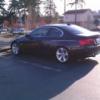Its actually very simple with a little bit of debunking.
Typical Processors (Desktop or Notebook; Notebook-Desktop Hybrid Processors used in 7th gen to keep size down) are meant to clock at the fastest speed to handle less tasks than a server processor would need to with less cores.
A Server Processor typically has more cores (Sometimes a lot of Cores), and because it has so many, the clock speed can be lowered because there is already so much hardware working on the task.
Kind of confusing still, but hopefully you got the gist of it.
Think of it like
Cores = Workers
Clock Speed = Performance
Less Workers with Better Performance = Desktop / Notebook Processor
More workers with Lower Performance = Server Processor
Server Processors handle multitasking, and system performance and stability better though because they have more cores, and are not being "Over-Clocked."
The Power 7 Architecture typically has 4 to 256 Cores, and its a Server Processor, which has to handle a LOT of Tasks and keep the performance and stability ok.
Should the Wii U have a Power7 Architecture instead of PowerPC, would mean a HUGE leap in performance and it would be able to handle multi-tasking, etc. with a BREEZE. HOWEVER, they cost ALOT even with 4 Cores, so i can imagine PowerPC being the sweet spot.
Do people not understand power pc is dead?
Power 7 servers are 'expensive' though ibm actually uses its very affordable price for a high end server as an advertising bullet. Starting at $6,500 bucks, with some financing you could have a power 7 750 express for under 200 bucks a month, for about 36 months.
Not the power 7 processor itself. Its much, MUCH cheaper. Definately affordable.
However, power 7 is a SERIOUS departure in architecture for ibm.
The micro architecture was completely redesigned to take advantadge of the new edram technology, the entire core architecture has been repipelined from a high clock speed design to a power/performance focused design.
That means that the power 7 no longer falls into the same category of server processors.... It doesn't just get its power from more cores.
EACH CORE IN THE POWER 7 NETS OVER 2X GENERAL PERFORMANCE GAINS THAN A POWER 6 CORE CLOCKED A GHZ HIGHER.
It also uses less power, and makes less heat, and uses less memory (saves cost per core).
The entire architecture is made possible because of the new edram technology.
This is why its so easy to tell these rumours of tri core power pc with 3mb anonymous cache (some sources say its l2, which makes it more wrong, yet they say it uses power 7's ram technology, pointing to the 3mb as being what ibm mesnt by 'a lot of edram'.
Anyone who's even taken a glance at p7 wpuld be laughing their arse off at this point.
IBM increased the performance using their edram technology by REDUCING cache sizes.
Power 7's l1 cache is half the size of p6's at 32 kb. Since its the new embedded dram technology, bussed 8 ways, and acts like 6transistor sram (you thought mosys 1tsram was fast? this is 6t). And ibm was abble to lower the latency thanks to the reduced size to......
ZERO POINT FIVE NANO SECONDS.
That puts the memory bandwidth of power 7's 32kb of ram at 192 GB/s. at a core speed of 4GHz
Power 6s 64kb of edram has a latency of 0.8 ns.
So what would average person think would make a bigger difference? twice the ram, or 0.3ns less latency. The average person would always say double the ram.
But the p6 64kb l1 cache only gets 80GB/s.
I keep telling people, ram performance ain't about capacity.
What about l2? This is the one people claim is 3mb total. That is so wrong. That's as wrong as chocolate cheese.
P7 REDUCED its l2 cache by 16x!!!!
P7 has a 256kb l2 cache. Power 6 has a 4MB l2 cache.
This enables p7 to reduce latency to 2 ns for its l2 cache.
P6 has 5 ns latency. The results?
p7's 256kb l2 cache has a 256GB/s bandwidth per core at 4GHz..... While p6's 4MB l2 cache only gets a 160GB/s bandwidth at 5GHz.
Power and performance is not about more ram, and its not about clock speed.
Now, anyone who has been following these rumours should have one thing on their nind right now.
Hey 3dude, ibm said the wii u would use the same technology as power 7, they SPECIFICALLY said, and I quote 'lots of edram'.
At 4 cores, all those caches combined barely make a single MB. That's NOT 'lots of edram'.
You are absolutely correct. Although the performance is fantastic (and linearly scalable to clock speed) 1MB is most certainly NOT a lot of edram.
How about 32MB edram embedded on the actual die? Yeah, that's the ticket.
The final huge change Ibm made with memory architecture is that l3 cache is no longer put on a seperate chip placed next to the cpu.
Its been EMBEDDED ON THE DIE ITSELF SMACK DAB THE MIDDLE OF THE DIE RIGHT BETWEEN THE CORES.
So what does that do for performance?
Well p6 ALSO has a 32MB cache.... Lets compare.
P7 is set up so each core has up to 4MB l3 directly adjacent to it. Now, all cores CAN share the entirety of the pool. So, a single socket of p7 has 8 cores, with 4Mb l3 per core at 8 cores, for a total of 32MB.
That enabled Ibm to get latency down to 30ns for its l3 cache.
P6 had its l3 cache on a seperate chip. 32MB on it. This gave p6 a l3 latency of 35ns. How much of a difference did that 5ns make?
P6 gets 80GB/s for its l3 cache, shared between 2 cores, at 5GHz.
P7. l3 cache gets FIVE HUNDRED AND TWELVE GB/s shared by 8 cores at 4GHz.
Of course, if you only have 4 cores, that's 16MB for a bandwidth of 203 GB/s.
Power7's edram technology IS power 7. They are one and the same. You can't just use power 7's edram technology and NOT have a p7 architecture.
Wii u HAS power7, NOT power pc.
Power 7 gets better performance at a lower clock speed than power pc.
Power 7 gets better performance at lower temperatures than power pc.
Power 7 gets better performance at less power draw than power pc.
Plus, power pc is dead as a frontline processor. Died in 2005/2006 when Ibm lost the power mac contract.
Power 7 IS in wii u, its been confirmed, explicitely word for word by official ibm news feed.






























!["[The] Wii U Has A Horrible, Slow CPU" Comment Was Based On "Very Early Kits" - last post by 3Dude](https://thewiiu.com/uploads/profile/photo-thumb-3402.png?_r=1371304853)



